Emerging technologies meet entrepreneurial ideas
Ever seen a ballerina dance on a table? Or tried to climb Mount Everest inside a library? For those who attended UNC-Chapel Hill’s 2017 Global Entrepreneurship Week (GEW) event at Kenan Science Library, the answer is probably yes.
These surreal experiences were made possible by augmented and virtual reality technologies, which were showcased at the event and are now available in several libraries across campus. The discussion panel and demo session were part of UNC-Chapel Hill’s participation in GEW, an annual international celebration of entrepreneurship that draws participation from creative thinkers and innovation enthusiasts from 170 countries. For one week in November, Carolina students, faculty and staff join millions of other entrepreneurs around the world who take part in local events designed to spark new endeavors.
170 countries that participate in Global Entrepreneurship Week (GEW)
10 million people who participate in GEW events around the world
92% of teenagers play video games
87 virtual reality games and experiences available through UNC Libraries
![]() Explore classes on entrepreneurship and innovation, while getting involved in leadership and learning opportunities outside the classroom. Explore UNC courses on innovation and entrepreneurship.
Explore classes on entrepreneurship and innovation, while getting involved in leadership and learning opportunities outside the classroom. Explore UNC courses on innovation and entrepreneurship.
“Every year, program leaders from different countries get together and share best practices,” said Judith Cone, vice chancellor for innovation, entrepreneurship and economic development, who worked as vice president of the Kauffman Foundation when the organization helped invent and expand GEW across the world. “We try to hook entrepreneurs together globally so that there can be a cross-pollination of ideas.”
This year, the Carolina community kicked off the week by exploring the intersection of entrepreneurship and technologies, including artificial intelligence, gamification, and augmented and virtual reality. The celebration was sponsored by Cone’s Innovate Carolina team and supported by key staff from UNC Libraries. It not only gave attendees the chance to learn from a panel of faculty experts, but also the ability to test drive a few of the technologies for themselves.
Augmented and virtual reality transform the possibilities
For many, it was the first time they’d tried on a virtual reality (VR) headset or looked through augmented reality (AR) glasses. And they immediately experienced something transformative. Attendees saw that objects in the library where they stood had been augmented by computer-generated sensory input – in one case, a ballerina dancing on a small table that they could reach out and interact with.
“Augmented reality is like virtual reality, where you have virtual objects, but they are in the physical space around you,” explained Brian Moynihan, head of health technology and informatics at the UNC Health Sciences Library. “So people know where the walls, chairs and tables are. If there is a person standing in front of you, you would be able to see that person. You can take advantage of some things that you can’t with other applications.”
Dancing ballerinas aside, the uses of AR technology are anything but frivolous, Moynihan added. “We just a got a new device called the Epson Moverio that we are going to use to help out at the UNC Children’s Hospital,” he explained. “For children with cancer, we’re going to come up with a way for them to play a scavenger hunt game in augmented reality. The point is to get them up and moving out of bed because it makes them healthier. So we are going to create this game to make it happen.”
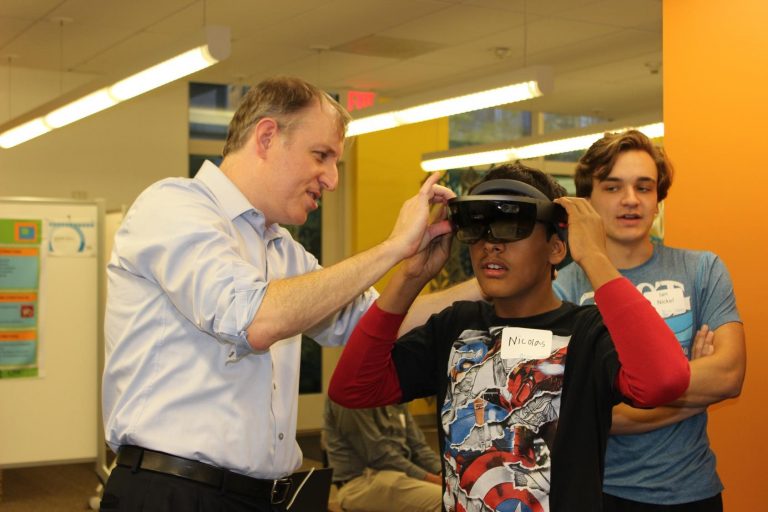
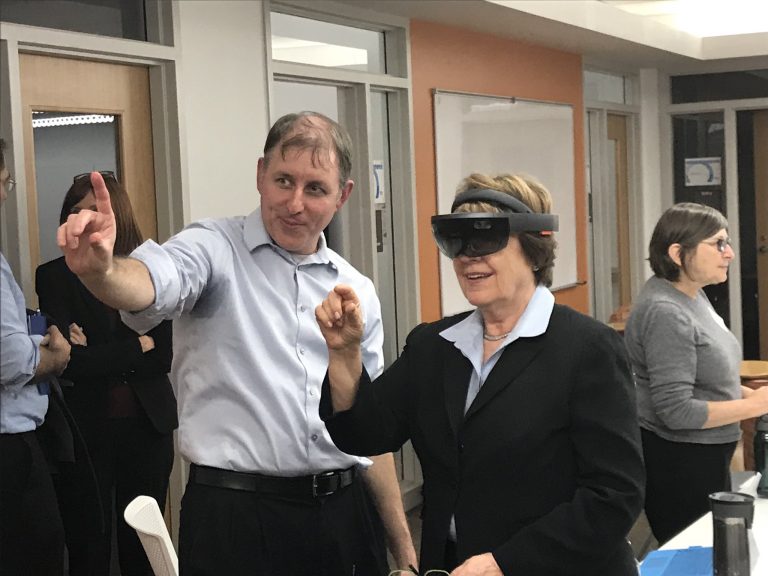
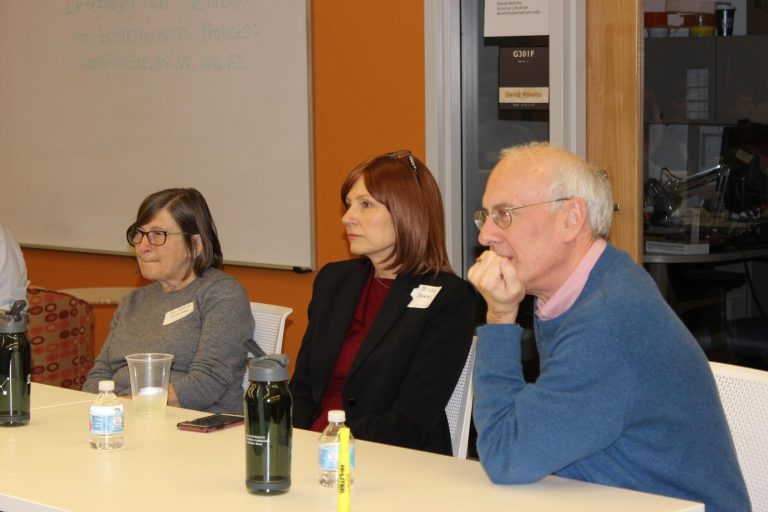
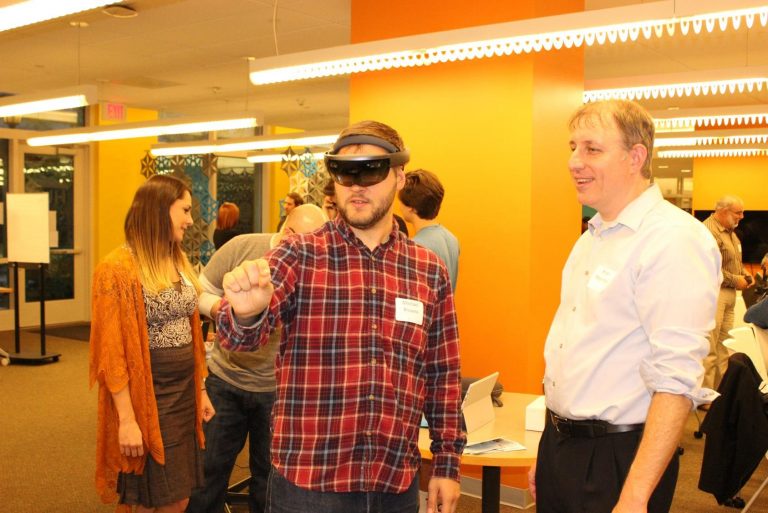

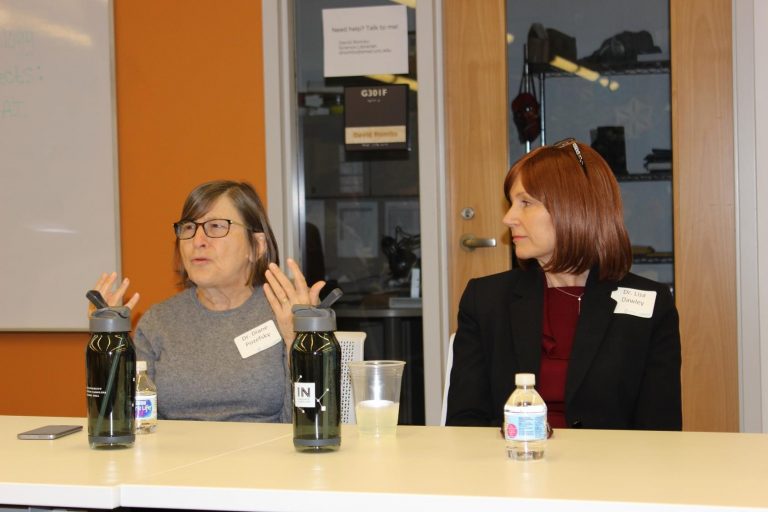

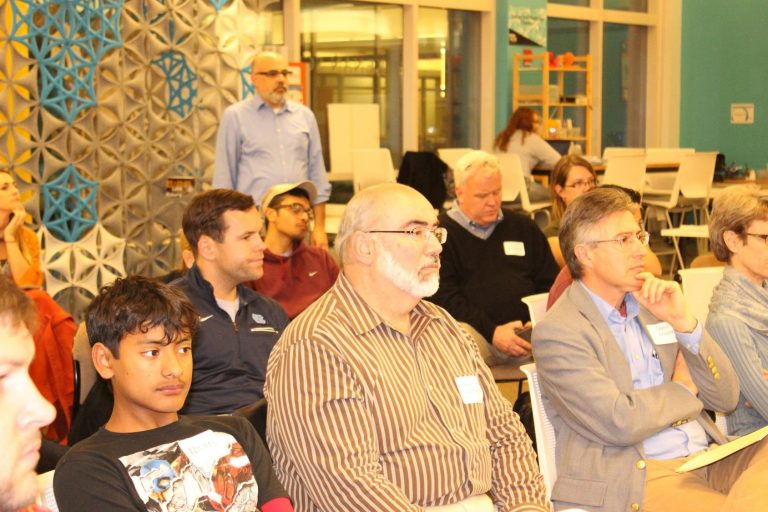
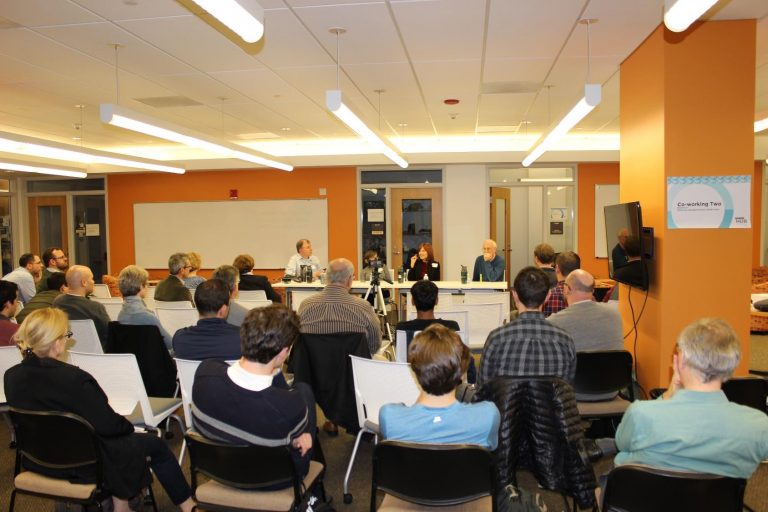
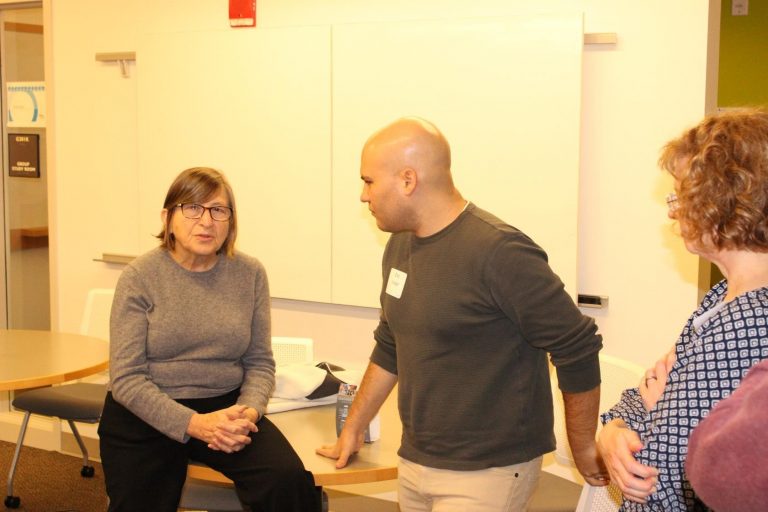
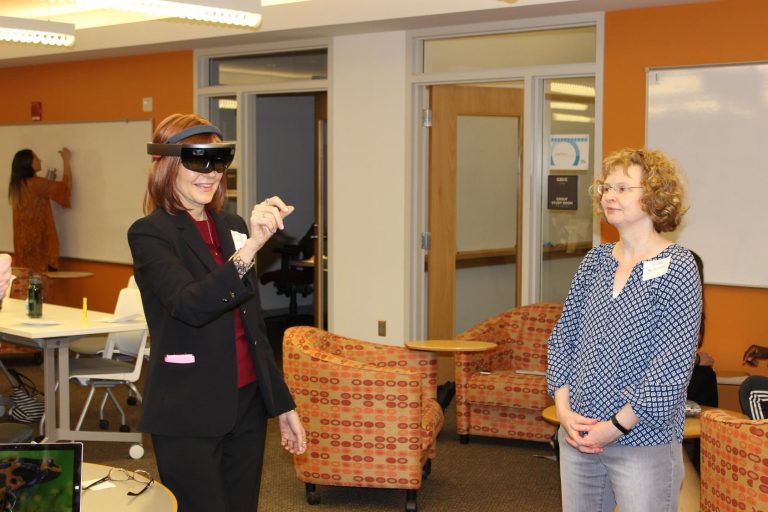
Augmented and virtual reality transform the possibilities
For many, it was the first time they’d tried on a virtual reality (VR) headset or looked through augmented reality (AR) glasses. And they immediately experienced something transformative. Attendees saw that objects in the library where they stood had been augmented by computer-generated sensory input – in one case, a ballerina dancing on a small table that they could reach out and interact with.
“Augmented reality is like virtual reality, where you have virtual objects, but they are in the physical space around you,” explained Brian Moynihan, head of health technology and informatics at the UNC Health Sciences Library. “So people know where the walls, chairs and tables are. If there is a person standing in front of you, you would be able to see that person. You can take advantage of some things that you can’t with other applications.”
Dancing ballerinas aside, the uses of AR technology are anything but frivolous, Moynihan added. “We just a got a new device called the Epson Moverio that we hope to use to help out at the UNC Children’s Hospital,” he explained. “For children with cancer, we want to come up with a way for them to play a scavenger hunt game in augmented reality. The point is to get them up and moving out of bed because it makes them healthier. So we hope to create this game to make it happen.”
Serious games shifts instructional models
For Lisa Dawley, clinical associate professor at the UNC School of Education, some of the greatest possibilities rest in the gamification of learning, which involves using elements from video games to enrich educational environments.
“92 percent of teenagers play games,” noted Dawley, who also serves as director of the UNC Master’s in Educational Innovation, Technology and Entrepreneurship program. “There are really engaging components of game design and play that can be overlaid on the learning experience to make it engaging as well.”

Using gaming technologies to improve classroom instruction, products and user experiences also requires a shift in thinking, said Diane Pozefsky, research professor and director of undergraduate studies in the UNC Department of Computer Science. “People talk about gamification in all the wrong ways,” she said. “They talk about counting numbers, and if I give you points, I gamify.” However, Pozefsky said that the real essence of gamification is being able to learn by exploring, instead of having a guru come tell students exactly what to do.
“I teach a software engineering course and a course on serious games, and both have a model that says: ‘How do you get people engaged enough to teach themselves, instead of forcing it down their throats?’” she said. “How can you create experiences so that students learn by doing instead of my telling them and them applying it?”
Ensuring that students are engaged enough to learn important lessons can have life-saving implications. David Lawrence, the Fred Eshelman Distinguished Professor in the UNC Eshelman School of Pharmacy, who teaches a lab safety course, recognizes the stakes and challenges of teaching students to make the right decisions in dangerous situations.
“When you are in a lab and are encountering things like a fire or explosion, the brain is the first thing to shut down,” Lawrence explained. “Students would ask: ‘Can you set off a small explosion in the auditorium and see how we respond?’” That was a request that Lawrence couldn’t grant. But he is looking at augmented reality and gaming technologies as ways to turn otherwise dry instructional content about lab rules into engaging simulated scenarios.
“Augmented reality is the way to go. You can be in an actual lab. You can work with other people in that lab and observe,” said Lawrence. “Wouldn’t it be neat if we could test making the wrong decisions on purpose and see what happens? That is what I ultimately see my lab safety course becoming – not just where we talk about things that other people have done, but where we go into the lab and try out all sorts of possibilities.”
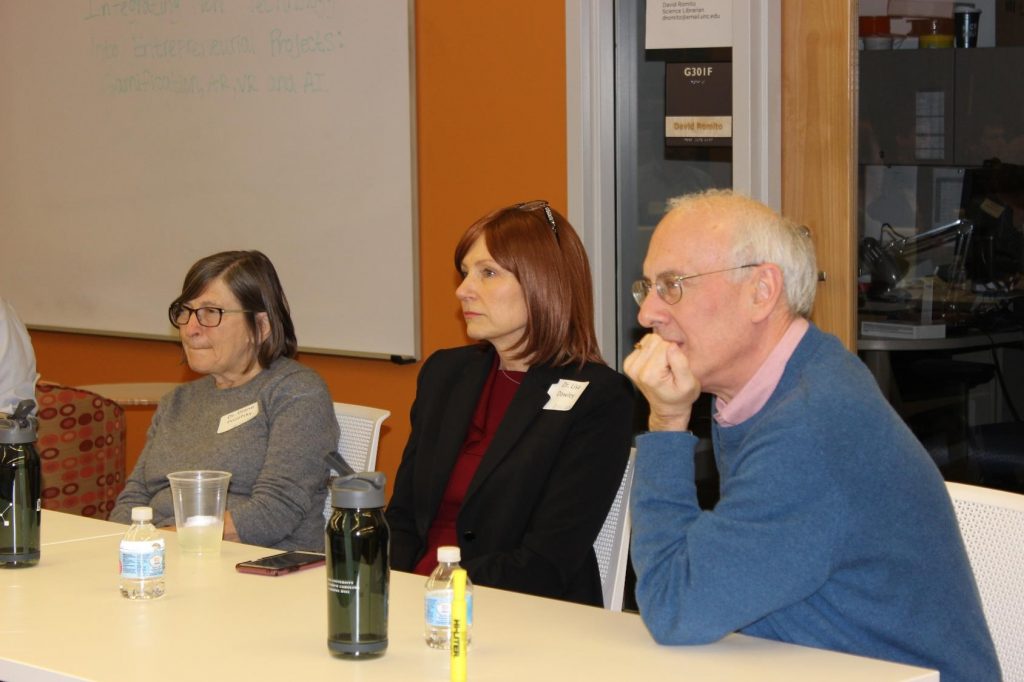
Artificial intelligence, new marketplace hold real promise
Artificial intelligence also has the potential to keep course content interesting by creating an Amazon-like experience for students, Dawley said. “Think of a traditional class or textbook. Chapter 1. Chapter 2. Chapter 3. It’s linear. It’s boring,” said Dawley. “Whenever you encounter a linear pathway in learning, you get bored with it because it’s predictable, and we know what’s coming.”
With artificial intelligence, the level of engagement can jump up several notches.
“Have you ever been to Amazon to buy a book? It has recommendations,” she said. “Now, imagine if that existed for education. That [artificial intelligence] brought opportunities for you to engage in a-la-carte.”
The application of technology for entrepreneurship stretches far beyond the classroom, and as Dawley noted, can shape an entirely new entrepreneurial mindset.
“Technology itself is making more of us think entrepreneurially. We can all be creators, designers, builders and producers of content. Along with that production, there are marketplaces that are emerging where people are sharing their ideas,” said Dawley, citing Google Blocks, Kindle and Apple iTunes as examples. “The ability to self-publish our individual work and getting rid of the middle man is a growing trend that will keep encouraging entrepreneurial thinking.”
Diving in to daunting technologies
For many faculty, students and staff, the most significant hurdle with using technology for entrepreneurial projects is simply getting started. But as Moynihan pointed out, access and training should never be an obstacle because library teams are available to help. Some of the new AR and VR technologies are available for people to try and check out, while the library staff can demo others. The process is as simple as signing up for a session online through UNC Libraries, which provides resources like the Kenan Science Library Makerspace and virtual reality technologies. or “You don’t have to be an expert to get started,” said Moynihan. “If you just want jump in to try it, use it for an educational application, or use an existing technology and tweak it a little bit, then you can definitely do that.”

 | UNC-CH
| UNC-CH